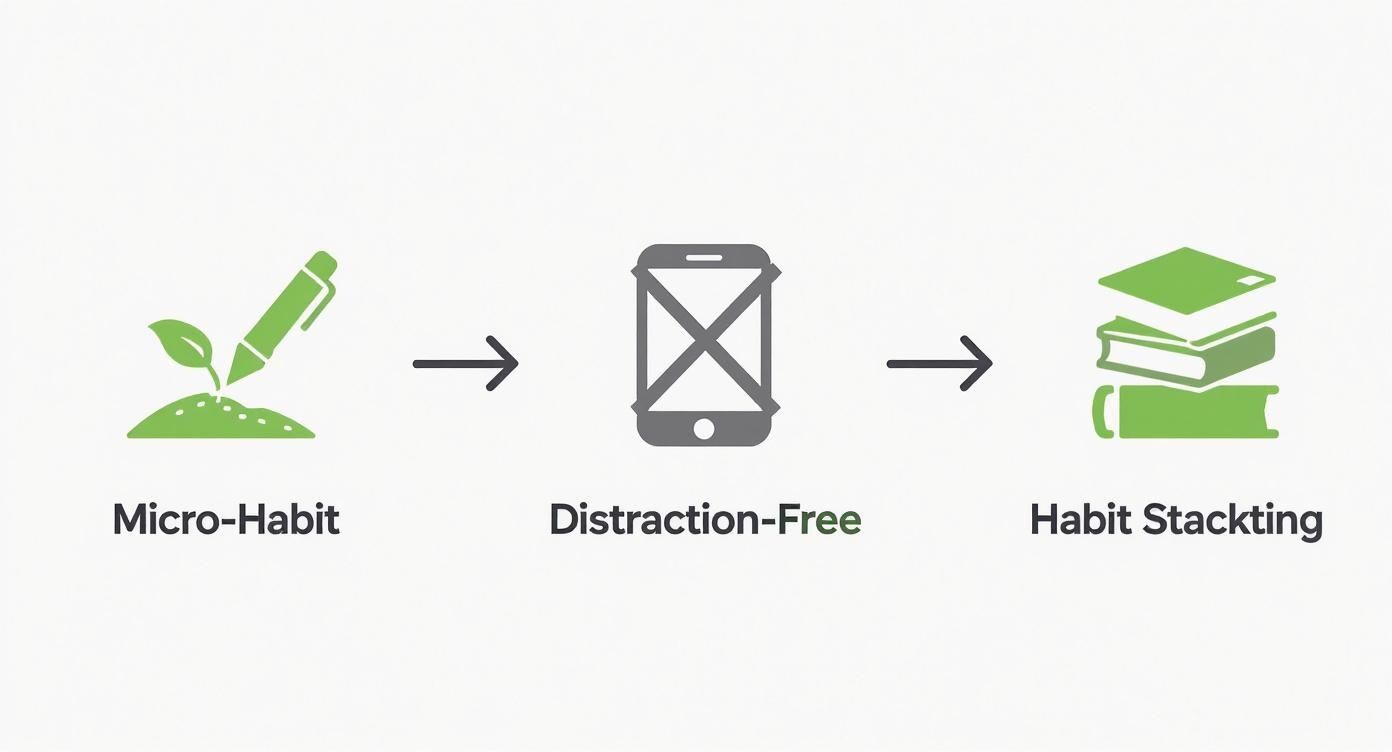The first step to beating writer’s block is realizing it’s not a single, monolithic beast. It’s a symptom. The real trick is to figure out what's really going on—are you burnt out, scared, or just trying too hard?—and then take one tiny, deliberate step forward.
Forget waiting for inspiration to strike. That’s a myth. The real key is to pick one small action that breaks the inertia and gets your creative engine turning over again.
Understanding Why Writer's Block Happens

Let’s get one thing straight: staring at a blank page doesn’t mean you’ve lost your touch or you’re a bad writer. It’s a universal hurdle, not a personal failing.
Think of it less as a "block" and more as your brain's check-engine light. It’s a signal that something in your process needs a quick look.
This feeling of being stuck is incredibly common. One study found that only 6% of first-year students said they never experienced writer's block, while a massive 70% dealt with it on occasion. And trust me, it doesn't just go away after college; it's a challenge that follows you throughout your career.
The term itself was officially coined way back in 1947, so creatives have been wrestling with this for a long, long time. Usually, the reasons you feel stuck boil down to just a few usual suspects.
Common Triggers Behind the Blank Page
Most of the time, you can trace that stuck feeling back to one of these four culprits. Naming the enemy is half the battle.
- Perfectionism: This is the big one. The pressure to make every sentence perfect right out of the gate is paralyzing. You end up editing as you go, strangling your momentum before it even has a chance to build.
- Fear: It can be fear of what others will think, fear of not living up to your own standards, or even the quiet fear that you just don't have anything valuable to say.
- Burnout: Sometimes, the problem isn't creative—it's physical. If you're sleep-deprived, mentally exhausted from overworking, or just running on fumes, your creative well is going to be bone dry.
- Lack of Clarity: You might be stuck simply because you don’t have a crystal-clear picture of what you’re trying to say. Without a destination in mind, it's impossible to take the first step.
The secret to getting ahead is getting started. The secret of getting started is breaking your complex, overwhelming tasks into small manageable tasks, and then starting on the first one. - Mark Twain
Figuring out which of these is your specific trigger is everything. If you're struggling just to come up with an angle, our guide on how to come up with good ideas for posts has some practical starting points. For a deeper dive, this comprehensive guide on overcoming writer's block is also a fantastic resource.
Pinpoint Your Block and Find Your First Step
Feeling overwhelmed? Use this quick-reference table to identify what's holding you back and find the single most effective action you can take right now.
| Type of Block | What It Feels Like | Your First Step |
|---|---|---|
| Perfectionism | "This isn't good enough. I need to get this sentence perfect before I move on." | Start a 5-minute "free write" where you're not allowed to hit backspace. Just get words down. |
| Fear | "What if people hate this? What if I have nothing new to say?" | Write down the absolute worst-case scenario. Then, write for an audience of one: yourself. |
| Burnout | "I'm just too tired to think. My brain feels like mush." | Close the laptop. Go for a 15-minute walk without your phone. Seriously. |
| Lack of Clarity | "I don't even know where to start. What's the point of this piece?" | Talk it out. Use a voice recorder and just ramble about your topic for 2 minutes. |
Finding your specific trigger and taking one small, corresponding action is often all it takes to break the cycle. Don't try to solve everything at once—just focus on that first step.
Shift Your Mindset to Beat Writing Anxiety

Before you even think about typing a single word, the real work begins. It’s not about finding the perfect opening line; it's about winning the battle in your head. I've seen it time and time again—writer's block is rarely about a lack of skill. It's almost always about the anxiety that wraps itself around the act of creating.
That sinking feeling you get staring at a blank page? It’s not a sign you’re a bad writer. It's just your inner critic being way too loud. That voice is a fantastic editor when you're polishing a final draft, but it’s poison when you’re just trying to get ideas out.
The first move is to politely (or not-so-politely) tell that critic to take a hike.
Research backs this up, pointing to things like anxiety, stress, and—the big one—perfectionism as the main culprits behind writer's block. The fear of what others will think and that obsessive need for the perfect sentence can paralyze you completely. If you want to go down the rabbit hole, you can read the full research about writing apprehension.
This is why you have to untangle your self-worth from your word count. Your value as a creator has nothing to do with how many words you crank out in an hour.
Embrace the Messy First Draft
Here’s the single most liberating mindset shift you can make: give yourself permission to write badly.
Seriously. The "messy first draft" isn't a failure; it's the entire point. It’s the block of clay you need before you can even think about sculpting. A sculptor doesn’t start with a finished statue, they start with a raw, ugly chunk of marble and start chipping away. Your first draft is that chunk of marble.
The goal is not to write a perfect article. The goal is to get something on the page. You can’t edit a blank page, but you can always improve a messy one.
Adopting this mindset transforms the pressure of perfection into the freedom of just exploring. The blank page loses its power when your only goal is to fill it with anything.
Uncover Your Hidden Writing Fears
Sometimes, the anxiety that’s holding you back is lurking just below the surface. You might not even be consciously aware of the specific fear that’s got you stuck. A quick journaling exercise can drag these fears into the light, where they're much easier to deal with.
Grab a notebook and try answering these prompts:
- "If I write this piece perfectly, the best thing that could happen is..." This helps expose the impossibly high stakes you’ve set for yourself.
- "If I write this poorly, my biggest fear is that people will think..." This forces you to name your fear of judgment head-on.
- "The most intimidating part of this writing project is..." This pinpoints exactly where the friction is.
Once you write these fears down, you strip them of their power. You’ll probably find they look a lot less scary on paper than they feel rattling around in your head. This mental reset is the foundation you need to build momentum and finally let the words flow.
Practical Exercises to Get Words Flowing Now

Sometimes the only way out is through. You can overthink writer's block into a massive, shadowy beast, but the fastest way to shrink it back down to size is to stop thinking and start doing.
These aren't about writing the perfect sentence. Forget perfect. The goal here is just to get your fingers moving and build a little momentum. Think of them as a quick warm-up for your brain—low-stakes drills that remind you what it feels like to create without that nagging inner critic on your shoulder.
Master the Freewriting Sprint
This one is a classic for a reason: it flat-out works. The idea is dead simple. Set a timer for a laughably short amount of time—five or ten minutes is perfect—and just write. Don't stop.
The rules are simple, but you have to stick to them:
- Keep typing, no matter what. If your brain goes blank, literally type "my brain is blank" until a new thought shows up. The goal is continuous motion.
- Zero editing. Typos, weird grammar, half-baked ideas... leave them all. Hitting the backspace key is strictly forbidden.
- No judgment allowed. Let whatever garbage, genius, or random thought that pops into your head spill onto the page.
This exercise forces a separation between your "creator brain" and your "editor brain." They're two different functions, and trying to do both at once is what causes the traffic jam. A good sprint proves you can still produce words.
The most powerful part of a freewriting sprint? It gives you physical proof that you're not actually 'blocked'—you're just overthinking. You can't edit a blank page, but you can almost always pull one good idea from a messy five-minute brain dump.
Use a Word Ladder to Spark Connections
If a total free-for-all feels like too much, try a word ladder. It's a playful little game that nudges your brain into making the kind of unexpected connections that lead to great ideas.
Start with one word related to your topic. Let's say you're stuck on a post about productivity. Your word could be "focus."
Now, what's the very next word that comes to mind? Maybe "laser." From "laser," you think "beam." From "beam," maybe "sunlight." Your chain could look something like this:
Focus → laser → beam → sunlight → energy → coffee → routine.
Boom. In under 30 seconds, you've built a bridge from "focus" all the way to "routine"—a brand new angle you can now explore. It's not about finding the "right" words; it's about following your brain's natural trail of breadcrumbs to see where it leads.
Brainstorm a Simple Social Media Post
Sometimes, the sheer size of a blog post is the problem. A 2,000-word beast is intimidating. So, shrink the task. Trick your brain into cooperating by aiming for something small and manageable.
Challenge yourself to write a single LinkedIn post on your topic. This is surprisingly effective because it forces you to be ruthless with your ideas. You have to get straight to the point.
Struggling with that big article on leadership? Try drafting a quick post titled, "The one mistake new managers make in their first 30 days." This tiny, focused task often helps you find the core idea you were wrestling with all along. If you want a few more pointers, we've got some great tips on how to write LinkedIn posts that really connect.
By getting your hands dirty with these exercises, you break the cycle of staring at the screen and prove to yourself that the words are still there, waiting for you to let them out.
Build a Writing Routine That Actually Sticks
Let's be honest: waiting for the muse to show up is a terrible strategy. Inspiration is fickle. It's the friend who promises to help you move and then ghosts you on the day. Relying on it is how you end up staring at a blinking cursor, feeling like you’ve completely lost your touch.
The secret to beating the blank page isn't some magical creative spark. It’s a routine. A solid, dependable system that gets you to the keyboard and keeps you there, even on the days you'd rather be doing literally anything else.
This isn’t about locking yourself in a room for four-hour writing sprints. It’s about building a sustainable practice with tiny, intentional habits that are almost too easy to ignore. It’s about creating a system so simple that writer’s block never even gets an invitation to the party.
Design Your Ideal Writing Space
Your brain is constantly taking cues from your environment. If you try to write on the same couch where you binge-watch Netflix, your mind gets confused. It associates that spot with relaxation, not focus. The same goes for a cluttered desk piled high with bills and to-do lists—that’s a stress zone.
You need to create a dedicated space. It doesn’t have to be a separate office; it can be a specific chair at the kitchen table or a corner of your bedroom. When you're in that spot, it’s time to write. Period.
Keep it clean and have everything you need ready to go. And for the love of focus, put your phone in another room or flip on "Do Not Disturb." This simple act tells your brain, "Okay, this is happening. It's writing time." You're removing the mental hurdles that make procrastination so tempting.
Your writing routine doesn’t need to be perfect, it just needs to exist. A flawed system you actually follow is infinitely better than a perfect one you don't. The goal is consistency, not intensity.
Leverage the Power of Habit Stacking
Trying to wedge a brand-new habit into your day using sheer willpower is a recipe for failure. A much smarter approach is to piggyback it onto something you already do without thinking. This is a game-changing technique called habit stacking.
The formula is dead simple: "After I [CURRENT HABIT], I will [NEW HABIT]."
Think about your non-negotiable daily rituals. That first cup of coffee in the morning? That’s your anchor.
Here's how you can put it into practice:
- "After I pour my morning coffee, I will open my laptop and write for 15 minutes."
- "After I get back from my lunch break, I will spend 10 minutes brainstorming ideas."
- "Before I shut down my computer for the day, I will jot down three bullet points for tomorrow's post."
By tethering your writing to an existing habit, you're essentially hijacking your brain's autopilot. The first action becomes a trigger for the second, making your writing practice feel like a natural part of your day instead of another chore on your to-do list. It’s a small tweak, but it makes building a sticky routine dramatically easier.
Use Modern Tools as Your Creative Partner
Sometimes, the problem isn't a lack of ideas—it's the pressure of the blank page. We’ve all been there, staring at a blinking cursor on a formal document, feeling the weight of perfectionism kick in.
This is where the right tools can feel less like software and more like a creative partner, helping you sidestep the parts of the process that always trip you up.
Think of it less as a shortcut and more as a collaborator. It’s not about replacing your voice; it’s about finding a different door to unlock it when the main one feels stuck.
Capture Ideas Without the Pressure of Typing
Let’s say you need to write a LinkedIn post about a recent win at work. The very idea of structuring it, finding the perfect hook, and writing a killer CTA feels like a monumental task.
This is the perfect moment to just talk it out.
Using a tool with voice recording, like we’ve built into PostFlow, lets you simply ramble. You can talk through the project, the challenges, the unexpected wins, and the key lessons learned without a single thought about grammar or sentence structure. This is how you capture your raw, authentic thoughts before that inner critic even has a chance to wake up.
Speaking your ideas out loud has a funny way of clarifying them. It takes the pressure off, turning a dreaded writing task into a simple storytelling session with yourself.
Technology’s best role in creativity is to remove friction. When you can capture an idea as easily as you can speak it, you eliminate the single biggest barrier to getting started.
This visual breaks down a simple routine that works wonders. It’s all about combining small habits with a focused environment—the foundation for consistently beating writer's block.

This flow—from micro-habits to distraction-free work and habit stacking—creates a powerful loop that makes consistent writing feel almost effortless.
Turn Writing into a Conversation
Here’s another mental flip that works like a charm: reframe writing as an interview. Instead of trying to pull ideas out of thin air, what if someone was there to ask you the exact right questions to draw them out?
This is the whole idea behind AI interview modes. The tool essentially acts as a journalist, asking you probing questions about your topic.
- "What was the single biggest challenge you faced on that project?"
- "Walk me through the moment you knew you had a breakthrough."
- "What's the one lesson you really want others to take from this?"
This conversational style tricks your brain out of "writing mode" and into "talking mode," which for most of us is far more natural and fluid. It helps you uncover angles you might have missed and generates all the raw material you need for a killer post.
Of course, a lot of people wonder if this approach still feels authentic. It’s a fair question. We put together a guide that explores how you can stay authentic when using tools or AI, ensuring your unique voice always shines through.
Experiment Safely with Multi-Version Editing
Finally, let's talk about the fear of "messing up" a perfectly good draft. This is a huge, often unspoken, cause of writer's block.
Tools with multi-version editing give you a safety net.
You can spin up multiple drafts from your voice notes or AI interview, playing with different hooks, tones, and angles without ever losing your original train of thought. This freedom is incredibly liberating. It encourages you to take risks and get creative, knowing you can always hit "undo" and go back to a version that worked.
A simple feature like this transforms your writing platform from a basic word processor into a secure creative sandbox.
Got Questions About Writer's Block? Let's Clear a Few Things Up.
Even when you're armed with a bunch of great tactics, some nagging questions about writer's block always seem to surface. I hear them all the time. Let's tackle the most common ones so you have a clearer path forward the next time you feel that all-too-familiar wall go up.
So, How Long Does This Last, Anyway?
Honestly, there’s no magic number. How long a block lasts usually mirrors what’s causing it in the first place. If you're just tired or had a long day, it might only be a few hours. A quick walk or one of those warm-up exercises we talked about can often shake it loose.
But the chronic kind? That can stick around for weeks, months, or even longer. That's usually tied to the big stuff—serious burnout, anxiety, or major life stress. The trick is to chip away at it with small, consistent actions instead of just waiting for inspiration to strike.
The real game isn't about outlasting the block. It's about being consistent. Small, daily efforts are what break the cycle, whether you've been stuck for a day or a month.
Is Writer's Block a Real Thing, Medically Speaking?
While you won't find "writer's block" listed in the DSM-5 (the big book of mental health disorders), it's absolutely recognized by psychologists as a genuine phenomenon. Think of it less as a formal condition and more as a symptom of other things, like performance anxiety, perfectionism, or even depression.
It's a very real experience, backed by cognitive science. So, even though you can't get a formal diagnosis for it, the impact it has on your work and creativity is 100% real and deserves to be taken seriously.
Does Changing My Scenery Actually Do Anything?
Oh, absolutely. Your environment sends powerful signals to your brain. If you’re trying to write at the same messy desk where you pay bills and deal with stressful emails, your brain starts to link that spot with pressure. No wonder the words won't come.
Carving out a dedicated writing space—even if it's just a specific armchair and a lap desk—tells your brain, "Okay, it's creative time now." Sometimes, just getting out of the house and heading to a coffee shop or a library is enough to break the mental loop of feeling stuck. It’s like hitting a reset button.
What if I've Tried Everything and I'm Still Stuck?
I get it. If you've been consistently trying different strategies and still feel completely paralyzed, it might be a sign of something deeper than a typical creative slump. This is often where real burnout or an underlying mental health challenge comes into play.
In that situation, the best—and kindest—thing you can do for yourself is to take a real, intentional break. Step away from the project completely. If you need more ideas, this is a great resource with practical strategies to overcome writer's block. Sometimes, the only way forward is to truly step back, recharge, and come back to it with a fresh perspective.
Ready to turn those ideas into compelling content without the struggle? PostFlow uses a conversational AI, Emilia, to interview you, capture your unique expertise, and transform your spoken words into polished LinkedIn posts.
Stop staring at a blank page and start your PostFlow journey today.


